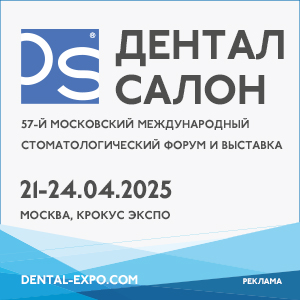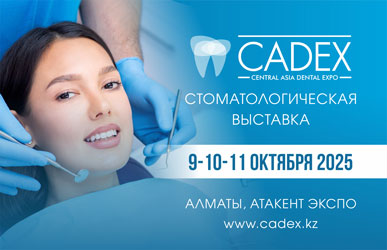DOI:
10.37988/1811-153X_2024_3_98The statistical characteristics of the electrical activity of the masticatory muscles in their functional impairments and pathology of the supporting tissues of the teeth
Downloads
Abstract
The aim of the study is to investigate changes in the electrical activity of the masticatory muscles in patients with various forms of parafunctions and combined dental arch deformity, characteristic of periodontal diseases.Materials and methods.
Three groups of individuals with muscle parafunctions were examined: 1st group (n=21) — patients with teeth clenching, 2nd group (n=19) — individuals with teeth grinding, 3rd group (n=16) — subjects with both teeth clenching and grinding. A control group consisted of 15 physically healthy volunteers. To identify and evaluate neurotic conditions, the K.K. Yahin, D.M. Mendeleevich clinical questionnaire was used. The activity of the masticatory muscles was studied using concentric electrodes on the “Viking Quest” electromyograph. Morphological abnormalities of the temporomandibular joint were identified on series of magnetic resonance imaging.
Results.
Increased abrasion of the hard tooth tissues during jaw clenching is more pronounced in the lateral segments of the dental arch and has a cup-shaped form (100% of patients); grinding of the teeth results in uneven abrasion across the dental arch (more than 85% of patients). Vegetative disorders, obsessive-phobic, and conversion disorders were observed in half of the cases among patients with various forms of masticatory muscle parafunction. All forms of parafunctional activity were accompanied by denervation processes of muscle fibers and an increase in activity amplitude. On the pain side of the temporomandibular joint, a 1.84-fold increase in indicators above the control level was observed in group 1, 1.48-fold in group 2 and 1.61-fold in group 3. On the opposite side, the prevalence of values was 1.58 times in the 1st group; 1.32 times in the 2nd group and 1.46 times in the 3rd group. Jaw clenching was found to shorten the duration of potentials on the painful side — 8.1% and on the opposite side — 3.8%; while grinding teeth, the increase in this indicator was 8.9% and 12.9%, respectively. Displacements of the articular disks in patients with jaw clenching are more often observed in the anterior direction (38% of cases), while during teeth grinding, they occur in the anterolateral vector (42% of cases). Due to the transfer of the vector of increased load from muscles to hard tissue elements of the joint, a compensatory reaction occurs in the form of accumulation of synovial fluid (37% of cases). The clinical picture worsened in the case of developed periodontitis.
Conclusion.
Increased abrasion of the hard tooth tissues has characteristic features depending on the clinical forms of the masticatory muscle’s parafunctions. An ecological momentary assessment of the chewing muscles condition can serve as a tool in the differential diagnosis of clinical forms of muscle parafunctions and to assess the frequency of their manifestations. Disorders of neurotic genesis occur in patients with various forms of parafunction of the masticatory muscles in half of the cases. Muscle parafunction, regardless of its shape, is accompanied by the processes of denervation of muscle fibers in their motor units and an increase in the amplitude of activity. Lateral dislocations of the articular discs are most characteristic in patients with teeth grinding, in the anterior direction — in persons with jaw clenching.
Key words:
temporomandibular joint, masticatory muscles, electromyography, magnetic resonance imagingFor Citation
[1]
Butyugin I.A., Bulycheva E.A., Trezubov V.N., Naidanova I.S., Alpatyeva Ju.V., Bulycheva D.S. The statistical characteristics of the electrical activity of the masticatory muscles in their functional impairments and pathology of the supporting tissues of the teeth. Clinical Dentistry (Russia). 2024; 27 (3): 98—107. DOI: 10.37988/1811-153X_2024_3_98
References
- Trezubov V.N., Bulycheva E.A., Trezubov V.V., Bulycheva D.S. Treatment of patients with disorders of the temporomandibular joint and masticatory muscles: clinical recommendations. 2nd edition. Moscow: GEOTAR-Media, 2024. Pp. 12—14 (In Russian).
- Mikami S., Yamaguchi T., Takahashi M., Kudo A., Saito M., Nakajima T., Maeda M., Saito T., Sakuma T., Takahashi S., Ishimaru T., Gotouda A. Examination of the relationship between masseter muscle activity during sleep and wakefulness measured by using a wearable electromyographic device. J Prosthodont Res. 2024; 68 (1): 92—99. PMID: 37005256
- Bulycheva E.A., Trezubov V.N., Rozov R.A., Bulycheva D.S. Efficiency of splint application in patients with masticatory muscle hypertension. In: proceedings “Topical issues of fundamental, clinical medicine and pharmacy”. Veliky Novgorod, 2020. Pp. 89—95 (In Russian). eLIBRARY ID: 44419342
- Chibisova M.A., Batukov N.M. Methods of X-ray examination and modern radiation diagnostics used in dentistry. The Dental Institute. 2020; 3 (88): 24—33 (In Russian). eLIBRARY ID: 44076240
- Bracci A., Lobbezoo F., Häggman-Henrikson B., Colonna A., Nykänen L., Pollis M., Ahlberg J., Manfredini D., International network for orofacial pain and related disorders methodology INfORM. Current knowledge and future perspectives on awake bruxism assessment: Expert consensus recommendations. J Clin Med. 2022; 11 (17): 5083. PMID: 36079013
- Bulycheva E., Trezubov V., Chikunov S., Bulycheva D. The riddance of masticatory hypertension with mouthguards. Aesthetic Dentistry. 2019; 1—2: 84—89 (In Russian). eLIBRARY ID: 49275665
- Kishimoto T., Goto T., Ichikawa T. Prefrontal cortex activity induced by periodontal afferent inputs downregulates occlusal force. Exp Brain Res. 2019; 237 (11): 2767—2774. PMID: 31440800
- Mayboroda Yu.N., Khorev O.Yu., Bezrodnova S.M. Problems of diagnosis of neuromuscular and occlusive dysfunction. In: proceedings of the “Topical issues of clinical dentistry” conference. Stavropol, 2022. Pp. 120—127 (In Russian). eLIBRARY ID: 48557474
- Khaybullina R.R., Gerasimova L.P. Modern methods of diagnostics and treatment of patients with chronic generalized marginal periodontitis and bruxism. Parodontologiya. 2015; 1 (74): 31—34 (In Russian). eLIBRARY ID: 23413720
- Maximovskaya L.N., Bugrovetskaya O.G., Skorova A.V., Solovykh E.A. Morphofunctional characteristics of occlusal disturbances and function of maxillofacial system in patients with periodontal diseases. The Dental Institute. 2009; 4 (45): 36—37 (In Russian). eLIBRARY ID: 13058657
- Suganuma T., Ono Y., Shinya A., Furuya R. The effect of bruxism on periodontal sensation in the molar region: A pilot study. J Prosthet Dent. 2007; 98 (1): 30—5. PMID: 17631172
- Yilmaz G., Laine C.M., Tinastepe N., Özyurt M.G., Türker K.S. Periodontal mechanoreceptors and bruxism at low bite forces. Arch Oral Biol. 2019; 98: 87—91. PMID: 30468992
- Giovanni A., Giorgia A. The neurophysiological basis of bruxism. Heliyon. 2021; 7 (7): e07477. PMID: 34286138
- Pisarevsky Yu.L., Naidanova I.S., Pisarevsky I.Yu., Pershin V.A. Features of electrophysiological changes in the parafunctional activity of the masticatory muscles in patients with signs of bruxism and full dentition. In: proceedings of the “Theoretical and practical issues of clinical dentistry” conference. Saint-Petersburg: Military Medical Academy, 2023. Pp. 82—85 (In Russian). eLIBRARY ID: 59429767
- Barragán Nuñez M.I., Flores D.M., D.E L.A Torre Canales G., Quevedo H.M., Conti P.R., Costa Y.M., Bonjardim L.R. Influence of awake bruxism behaviors on fatigue of the masticatory muscles in healthy young adults. Braz Oral Res. 2023; 37: e080. PMID: 37531516
- Nykänen L., Manfredini D., Lobbezoo F., Kämppi A., Bracci A., Ahlberg J. Assessment of awake bruxism by a novel bruxism screener and ecological momentary assessment among patients with masticatory muscle myalgia and healthy controls. J Oral Rehabil. 2024; 51 (1): 162—169. PMID: 37036436
- Pisarevskiy Yu.L., Naidanova I.S., Marchenko M.V., Pisarevskiy I.Yu. Electromyography characteristics of the motor unit action potential of the lateral pterygoid muscle and bioelectrical activity of masticatory muscles during splint therapy for pain temporomandibular joint dysfunction. Stomatology. 2019; 6: 72—78 (In Russian). eLIBRARY ID: 41854859
- Arayasantiparb R., Tsuchimochi M., Mitrirattanakul S. Transformation of temporomandibular joint disc configuration in internal derangement patients using magnetic resonance imaging. Oral Sci. Int. 2012; 9, 43—48. DOI: 10.1016/S1348-8643(12)00025-0
- Valesan L.F., Da-Cas C.D., Réus J.C., Denardin A.C.S., Garanhani R.R., Bonotto D., Januzzi E., de Souza B.D.M. Prevalence of temporomandibular joint disorders: a systematic review and meta-analysis. Clin Oral Investig. 2021; 25 (2): 441—453. PMID: 33409693
- Mizuhashi F., Ogura I., Mizuhashi R., Watarai Y., Oohashi M., Suzuki T., Saegusa H. Examination for the factors involving to joint effusion in patients with temporomandibular disorders using magnetic resonance imaging. J Imaging. 2023; 9 (5): 101. PMID: 37233320
- Lan K.W., Jiang L.L., Yan Y. Comparative study of surface electromyography of masticatory muscles in patients with different types of bruxism. World J Clin Cases. 2022; 10 (20): 6876—6889. PMID: 36051132
- Stafeev A.A., Solovyov S.I., Khizhuk A.V., Anokhina A.A., Porubai V.V. The influence of students’ psychoemotional state on Bruxism. In: proceedings of the “Dentistry of the slavic states” conference. Belgorod: Belgorod State University, 2022. Pp. 262—264 (In Russian). eLIBRARY ID: 53845121
- Bulycheva E., Trezubov V., Spitsyna O., Bystrova Y., Alpatyeva Y., Bulycheva D. Criteria for assessing the quality of treatment of disorders of the masticatory and speech apparatus. Sovremennaya stomatologiya (Belarus). 2020; 4 (81): 87—90 (In Russian). eLIBRARY ID: 44597955
- Abe Y., Nakazato Y., Takaba M., Kawana F., Baba K., Kato T. Diagnostic accuracy of ambulatory polysomnography with electroencephalogram for detection of sleep bruxism-related masticatory muscle activity. J Clin Sleep Med. 2023; 19 (2): 379—392. PMID: 36305587
- Nikitin S.S. Electromyographic stages of denervation/reinnervation process at neuromuscular diseases: need for revision. Neuromuscular Diseases. 2015; 2: 16—24 (In Russian). eLIBRARY ID: 23760154
- Khawaja S.N., Crow H., Mahmoud R.F., Kartha K., Gonzalez Y. Is there an association between temporomandibular joint effusion and arthralgia? J Oral Maxillofac Surg. 2017; 75 (2): 268—275. PMID: 27663534
- Zhang J., Yu W., Wang J., Wang S., Li Y., Jing H., Li Z., Li X., Liang M., Wang Y. A comparative study of temporomandibular joints in adults with definite sleep bruxism on magnetic resonance imaging and cone-beam computer tomography images. J Clin Med. 2023; 12 (7): 2570. PMID: 37048653
- Orlando B., Chiappe G., Landi N., Bosco M. Risk of temporomandibular joint effusion related to magnetic resonance imaging signs of disc displacement. Med Oral Patol Oral Cir Bucal. 2009; 14 (4): E188—93. PMID: 19333188
- Yoshida H., Ishikawa H., Himejima A., Ikeda H., Tani M., Taniguchi R., Iseki T., Tsutsumi Y. Transmission electron microscopic study of the surface layer of surgical resected disc specimens in human temporomandibular joint. Med Mol Morphol. 2024; 57 (1): 76—81. . PMID: 38071257
Downloads
Received
May 13, 2024
Accepted
August 22, 2024
Published on
October 2, 2024












